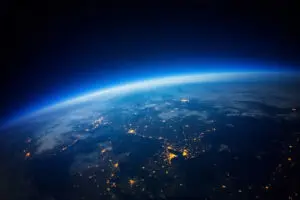By Tom Ellis
 Most dystopian fiction is set in the future, near or distant. But consider our present reality: a visibly accelerating rise in average global temperatures from year to year, leading to rapidly melting ice caps and glaciers, rising sea levels, the collapse of ecosystems, and the relentless pounding of unprecedented storms, droughts, floods, and wildfires worldwide; coupled with growing political and economic chaos and warfare, along with a rise in fascism and the fading of democratic ideals and corruption of institutions; and finally, the inexorable depletion of global fossil fuel reserves, promising a steady and accelerating rise in the prices of net energy — and therefore of everything else on the market. So the dystopian future is here, now. For this reason, I have decided to share my own dystopian fantasy, whose setting is not some imagined future, but right here and now.
Most dystopian fiction is set in the future, near or distant. But consider our present reality: a visibly accelerating rise in average global temperatures from year to year, leading to rapidly melting ice caps and glaciers, rising sea levels, the collapse of ecosystems, and the relentless pounding of unprecedented storms, droughts, floods, and wildfires worldwide; coupled with growing political and economic chaos and warfare, along with a rise in fascism and the fading of democratic ideals and corruption of institutions; and finally, the inexorable depletion of global fossil fuel reserves, promising a steady and accelerating rise in the prices of net energy — and therefore of everything else on the market. So the dystopian future is here, now. For this reason, I have decided to share my own dystopian fantasy, whose setting is not some imagined future, but right here and now.
Part I: The Gaia Movement defined.
So…imagine that somewhere, or in many places at once, a self-replicating Gaia movement were to start, whose adherents call ourselves, simply, “Gaians.” Unlike most others in our dying world, Gaians pledge our first allegiance not to any nation, flag, ideology, or religious creed, but rather to Gaia, our living planet. And imagine that we adopted for our unifying symbol something like the above image: an image of the living Earth, or Gaia, surrounded by a Moebius band, which embodies a mathematical, or topological paradox: a solid (you cut it out with scissors, then twist one end and tape it together) that nevertheless has only one side, not two. If you trace a pencil starting at any point on it, inside or out, your line will move effortlessly from the inside of the band to the outside and back again, without ever leaving the surface. And you can twist it in your hand so that any “inside” of the band becomes the ”outside” and vice versa.
This is not the only symbol, of course. There are many others, such as the living Earth image all by itself, or a Solar Cross — a universal symbol of wholeness that can be found in nearly every other culture on the planet. Some excellent starting points for a worldwide Gaia movement already are available. My friend Erik Assadourian, for example, already has created a beautiful website called Gaianism, and has set up an E-list and ongoing set of Zoom-based virtual gatherings where fellow Gaians (like myself) from all over the planet can meet periodically and exchange essays, ideas, and links with one another.
Gaians differ from every other nationality, religion, or political ideology in one crucial respect: it is the only identity label I know that includes everyone (and all other living beings), excluding no one at all. So if I am a Gaian, so are you — whether you know it or not. A Gaian is any living being, human or otherwise, who inhabits this planet — the only living planet we will ever know first-hand — and who processes matter, energy, and information as an open system, taking in and recycling sunlight, water, air, and minerals in order to keep on keeping on. So we Gaians reject any artificial boundary between “humanity” and “nature.” Nature (or Gaia), is the system of which we are a part — not just a “resource” whose only value is to produce commodities — mineral or biological — for human consumption.
It’s important to note that Gaianism, or (my preferred term) Gaianity, is not a religion, per se, (although many may disagree with me on this, and I respect their views). That is, Gaian theory and Gaian consciousness have nothing at all to say about the classical religious questions, such as the nature of God; the origins and destiny of the universe, life, or humanity; sin, redemption, or the path to salvation. You don’t “have to believe” anything to be a Gaian; our thinking is firmly rooted in the scientific method: what we can, in principle, know or ascertain about our planet, our ecosystems, and our species — not what we can’t.
Leave a Reply